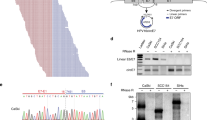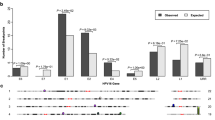Abstract
Virus integration into the host genome is a characteristic step during cervical carcinogenesis. Experimental data provide evidence that integration could result in increased levels of oncogene (E6/E7) transcripts. This is the first study in which the level of viral transcripts is correlated to the physical state of the viral genome in cervical intraepithelial neoplasia (CIN) and cervical carcinomas (CxCa). Using the APOT-assay integrate-derived transcripts only were detected in 3/28 (11%) CIN and in 28/55 (51%) carcinomas, respectively. The remaining biopsies contained either episome-derived transcripts only or both mRNA species. SybrGreen real time reverse transcriptase–PCR assays were used to quantify viral gene expression for (i) all transcripts initiated from p97, (ii) full-length E6, (iii) E6*I and (iv) E5 transcripts. E6/E7 transcript levels showed a broad distribution but similar median values irrespective of histopathological grading and physical state of the viral genome. Biopsies with integrate-derived transcripts only generally lacked E5-specific mRNA. Our data do not support the hypothesis that HPV integration invariably results in high levels of oncogene transcripts. Instead, constitutive expression of oncogene transcripts rather than the level of expression appears to be decisive for transformation and the maintenance of the malignant phenotype.
This is a preview of subscription content, access via your institution
Access options
Subscribe to this journal
Receive 50 print issues and online access
$259.00 per year
only $5.18 per issue
Buy this article
- Purchase on Springer Link
- Instant access to full article PDF
Prices may be subject to local taxes which are calculated during checkout





Similar content being viewed by others
References
Alazawi W, Pett M, Arch B, Scott L, Freeman T, Stanley MA et al. (2002). Changes in cervical keratinocyte gene expression associated with integration of human papillomavirus 16. Cancer Res 62: 6959–6965.
Andersson S, Hansson B, Norman I, Gaberi V, Mints M, Hjerpe A et al. (2006). Expression of E6/E7 mRNA from ‘high risk’ human papillomavirus in relation to CIN grade, viral load and p16INK4a. Int J Oncol 29: 705–711.
Arends MJ, Buckley CH, Wells M . (1998). Aetiology, pathogenesis, and pathology of cervical neoplasia. J Clin Pathol 51: 96–103.
Baker CC, Phelps WC, Lindgren V, Braun MJ, Gonda MA, Howley PM . (1987). Structural and transcriptional analysis of human papillomavirus type 16 sequences in cervical carcinoma cell lines. J Virol 61: 962–971.
De Marco L, Gillio-Tos A, Bonello L, Ghisetti V, Ronco G, Merletti F . (2007). Detection of human papillomavirus type 16 integration in pre-neoplastic cervical lesions and confirmation by DIPS-PCR and sequencing. J Clin Virol 38: 7–13.
Duensing S, Lee LY, Duensing A, Basile J, Piboonniyom S, Gonzalez S et al. (2000). The human papillomavirus type 16 E6 and E7 oncoproteins cooperate to induce mitotic defects and genomic instability by uncoupling centrosome duplication from the cell division cycle. Proc Natl Acad Sci USA 97: 10002–10007.
Duensing S, Munger K . (2004). Mechanisms of genomic instability in human cancer: insights from studies with human papillomavirus oncoproteins. Int J Cancer 109: 157–162.
Durst M, Dzarlieva-Petrusevska RT, Boukamp P, Fusenig NE, Gissmann L . (1987). Molecular and cytogenetic analysis of immortalized human primary keratinocytes obtained after transfection with human papillomavirus type 16 DNA. Oncogene 1: 251–256.
Durst M, Glitz D, Schneider A, zur Hausen H . (1992). Human papillomavirus type 16 (HPV 16) gene expression and DNA replication in cervical neoplasia: analysis by in situ hybridization. Virology 189: 132–140.
Durst M, Seagon S, Wanschura S, zur Hausen H, Bullerdiek J . (1995). Malignant progression of an HPV16-immortalized human keratinocyte cell line (HPKIA) in vitro. Cancer Genet Cytogenet 85: 105–112.
Falcinelli C, van Belkum A, Schrauwen L, Seldenrijk K, Quint WG . (1993). Absence of human papillomavirus type 16 E6 transcripts in HPV 16-infected, cytologically normal cervical scrapings. J Med Virol 40: 261–265.
Funk JO, Waga S, Harry JB, Espling E, Stillman B, Galloway DA . (1997). Inhibition of CDK activity and PCNA-dependent DNA replication by p21 is blocked by interaction with the HPV-16 E7 oncoprotein. Genes Dev 11: 2090–2100.
Giulietti A, Overbergh L, Valckx D, Decallonne B, Bouillon R, Mathieu C . (2001). An overview of real-time quantitative PCR: applications to quantify cytokine gene expression. Methods 25: 386–401.
Hopman AH, Kamps MA, Smedts F, Speel EJ, Herrington CS, Ramaekers FC . (2005). HPV in situ hybridization: impact of different protocols on the detection of integrated HPV. Int J Cancer 115: 419–428.
IARC. (1995). Human papillomaviruses. IARC Monogr Eval Carcinog Risks Hum 64: 1–378.
Itoshima T, Fujiwara T, Waku T, Shao J, Kataoka M, Yarbrough WG et al. (2000). Induction of apoptosis in human esophageal cancer cells by sequential transfer of the wild-type p53 and E2F-1 genes: involvement of p53 accumulation via ARF-mediated MDM2 down-regulation. Clin Cancer Res 6: 2851–2859.
Jacobs MV, Snijders PJ, van den Brule AJ, Helmerhorst TJ, Meijer CJ, Walboomers JM . (1997). A general primer GP5+/GP6(+)-mediated PCR-enzyme immunoassay method for rapid detection of 14 high-risk and 6 low-risk human papillomavirus genotypes in cervical scrapings. J Clin Microbiol 35: 791–795.
Jeon S, Allen-Hoffmann BL, Lambert PF . (1995). Integration of human papillomavirus type 16 into the human genome correlates with a selective growth advantage of cells. J Virol 69: 2989–2997.
Jeon S, Lambert PF . (1995). Integration of human papillomavirus type 16 DNA into the human genome leads to increased stability of E6 and E7 mRNAs: implications for cervical carcinogenesis. Proc Natl Acad Sci USA 92: 1654–1658.
Klaes R, Woerner SM, Ridder R, Wentzensen N, Duerst M, Schneider A et al. (1999). Detection of high-risk cervical intraepithelial neoplasia and cervical cancer by amplification of transcripts derived from integrated papillomavirus oncogenes. Cancer Res 59: 6132–6136.
Luft F, Klaes R, Nees M, Durst M, Heilmann V, Melsheimer P et al. (2001). Detection of integrated papillomavirus sequences by ligation-mediated PCR (DIPS-PCR) and molecular characterization in cervical cancer cells. Int J Cancer 92: 9–17.
Melsheimer P, Vinokurova S, Wentzensen N, Bastert G, von Knebel Doeberitz M . (2004). DNA aneuploidy and integration of human papillomavirus type 16 e6/e7 oncogenes in intraepithelial neoplasia and invasive squamous cell carcinoma of the cervix uteri. Clin Cancer Res 10: 3059–3063.
Middleton K, Peh W, Southern S, Griffin H, Sotlar K, Nakahara T et al. (2003). Organization of human papillomavirus productive cycle during neoplastic progression provides a basis for selection of diagnostic markers. J Virol 77: 10186–10201.
Molden T, Kraus I, Karlsen F, Skomedal H, Nygard JF, Hagmar B . (2005). Comparison of human papillomavirus messenger RNA and DNA detection: a cross-sectional study of 4136 women >30 years of age with a 2-year follow-up of high-grade squamous intraepithelial lesion. Cancer Epidemiol Biomarkers Prev 14: 367–372.
Munger K, Baldwin A, Edwards KM, Hayakawa H, Nguyen CL, Owens M et al. (2004). Mechanisms of human papillomavirus-induced oncogenesis. J Virol 78: 11451–11460.
Munger K, Basile JR, Duensing S, Eichten A, Gonzalez SL, Grace M et al. (2001). Biological activities and molecular targets of the human papillomavirus E7 oncoprotein. Oncogene 20: 7888–7898.
Munoz N, Bosch FX . (1992). HPV and cervical neoplasia: review of case–control and cohort studies. IARC Sci Publ, 251–261.
Nakagawa S, Yoshikawa H, Yasugi T, Kimura M, Kawana K, Matsumoto K et al. (2000). Ubiquitous presence of E6 and E7 transcripts in human papillomavirus-positive cervical carcinomas regardless of its type. J Med Virol 62: 251–258.
Ostor AG . (1993). Natural history of cervical intraepithelial neoplasia: a critical review. Int J Gynecol Pathol 12: 186–192.
Peitsaro P, Johansson B, Syrjanen S . (2002). Integrated human papillomavirus type 16 is frequently found in cervical cancer precursors as demonstrated by a novel quantitative real-time PCR technique. J Clin Microbiol 40: 886–891.
Pett MR, Alazawi WO, Roberts I, Dowen S, Smith DI, Stanley MA et al. (2004). Acquisition of high-level chromosomal instability is associated with integration of human papillomavirus type 16 in cervical keratinocytes. Cancer Res 64: 1359–1368.
Riethdorf S, Riethdorf L, Schulz G, Ikenberg H, Janicke F, Loning T et al. (2001). Relationship between telomerase activation and HPV 16/18 oncogene expression in squamous intraepithelial lesions and squamous cell carcinomas of the uterine cervix. Int J Gynecol Pathol 20: 177–185.
Romanczuk H, Howley PM . (1992). Disruption of either the E1 or the E2 regulatory gene of human papillomavirus type 16 increases viral immortalization capacity. Proc Natl Acad Sci USA 89: 3159–3163.
Rosty C, Sheffer M, Tsafrir D, Stransky N, Tsafrir I, Peter M et al. (2005). Identification of a proliferation gene cluster associated with HPV E6/E7 expression level and viral DNA load in invasive cervical carcinoma. Oncogene 24: 7094–7104.
Scheffner M, Werness BA, Huibregtse JM, Levine AJ, Howley PM . (1990). The E6 oncoprotein encoded by human papillomavirus types 16 and 18 promotes the degradation of p53. Cell 63: 1129–1136.
Sedman SA, Barbosa MS, Vass WC, Hubbert NL, Haas JA, Lowy DR et al. (1991). The full-length E6 protein of human papillomavirus type 16 has transforming and trans-activating activities and cooperates with E7 to immortalize keratinocytes in culture. J Virol 65: 4860–4866.
Solinas-Toldo S, Durst M, Lichter P . (1997). Specific chromosomal imbalances in human papillomavirus-transfected cells during progression toward immortality. Proc Natl Acad Sci USA 94: 3854–3859.
Sotlar K, Stubner A, Diemer D, Menton S, Menton M, Dietz K et al. (2004). Detection of high-risk human papillomavirus E6 and E7 oncogene transcripts in cervical scrapes by nested RT-polymerase chain reaction. J Med Virol 74: 107–116.
Van Tine BA, Kappes JC, Banerjee NS, Knops J, Lai L, Steenbergen RD et al. (2004). Clonal selection for transcriptionally active viral oncogenes during progression to cancer. J Virol 78: 11172–11186.
Vandesompele J, De Preter K, Pattyn F, Poppe B, Van Roy N, De Paepe A et al. (2002). Accurate normalization of real-time quantitative RT-PCR data by geometric averaging of multiple internal control genes. Genome Biol 3: RESEARCH0034.
von Knebel Doeberitz M, Bauknecht T, Bartsch D, zur Hausen H . (1991). Influence of chromosomal integration on glucocorticoid-regulated transcription of growth-stimulating papillomavirus genes E6 and E7 in cervical carcinoma cells. Proc Natl Acad Sci USA 88: 1411–1415.
Wentzensen N, Vinokurova S, von Knebel Doeberitz M . (2004). Systematic review of genomic integration sites of human papillomavirus genomes in epithelial dysplasia and invasive cancer of the female lower genital tract. Cancer Res 64: 3878–3884.
Zerfass-Thome K, Zwerschke W, Mannhardt B, Tindle R, Botz JW, Jansen-Durr P . (1996). Inactivation of the CDK inhibitor p27KIP1 by the human papillomavirus type 16 E7 oncoprotein. Oncogene 13: 2323–2330.
zur Hausen H . (2002). Papillomaviruses and cancer: from basic studies to clinical application. Nat Rev Cancer 2: 342–350.
Author information
Authors and Affiliations
Corresponding author
Rights and permissions
About this article
Cite this article
Häfner, N., Driesch, C., Gajda, M. et al. Integration of the HPV16 genome does not invariably result in high levels of viral oncogene transcripts. Oncogene 27, 1610–1617 (2008). https://doi.org/10.1038/sj.onc.1210791
Received:
Revised:
Accepted:
Published:
Issue Date:
DOI: https://doi.org/10.1038/sj.onc.1210791
Keywords
This article is cited by
-
Development of therapeutic vaccines for the treatment of diseases
Molecular Biomedicine (2022)
-
Understanding genomics and the immune environment of penile cancer to improve therapy
Nature Reviews Urology (2020)
-
Viral E6 is overexpressed via high viral load in invasive cervical cancer with episomal HPV16
BMC Cancer (2017)
-
Stratification of HPV-induced cervical pathology using the virally encoded molecular marker E4 in combination with p16 or MCM
Modern Pathology (2015)
-
HPV-assoziierte Kopf‑Hals‑Karzinome
HNO (2015)



